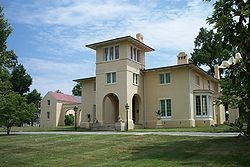Blandwood Mansion
Introduction
Text-to-speech Audio
Images
The mansion was originally built in 1795. Additions were made to the structure by A.J. Davis turning it into a Italianate wonder in 1844.

Backstory and Context
Text-to-speech Audio
The Blandwood Mansion was originally constructed in 1795 by Charles Bland.1 The residence then became home to North Carolina Governor John Motley Morehead. This farmhouse was transformed into an Italianate wonder in 1844 when A.J. Davis designed an addition.
The house served as quarters for Confederate General P.G.T. Beauregard during the Civil War. After the Confederacy fell, the house was temporarily used as headquarters for Union Generals Jacob Dolson Cox and John Schofield. On May 2, 1865, North Carolina Governor Zebulon B. Vance surrendered to Cox and Schofield in the Blandwood Mansion’s main parlor.2
The Blandwood Mansion was named a National Historic Landmark in 1988. Today it operates as a museum. While visiting the mansion, visitors can see 19th century art, architecture, furnishings, and landscapes.3
Cite This Entry
Lenox, Laney and Clio Admin. "Blandwood Mansion." Clio: Your Guide to History. March 28, 2016. Accessed April 28, 2025. https://theclio.com/tour/1129/6

